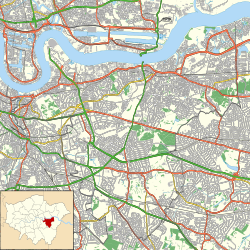Repository Woods
| Repository Woods | |
|---|---|
| Type | Military training area |
| Location | London, SE18 |
| Coordinates | 51°29′04″N 0°03′12″E / 51.4845°N 0.0534°E |
| Area | 7 hectares (17 acres) |
| Created | 1802 |
| Operated by | Ministry of Defence |
| Website | "Repository Woods" (on Parks & Gardens website) |
Repository Woods is a 7 acres (2.8 ha) deciduous woodland area to the west of the British Army's Woolwich Garrison in the Royal Borough of Greenwich in southeast London. Initially created for pleasure use in the early 19th century, it was later used for military training, and is designated at Grade II as the UK's earliest known purpose-built military training landscape. Its features include training and practice earthworks, a stream and man-made lake and terraces. A Rotunda, designed by John Nash in 1814, is nearby.
Features
[edit]The woods are in Woolwich on the boundary between Woolwich and Charlton parishes, north of Woolwich Common, Charlton Cemetery and the Napier Lines army depot, and south of Hillreach, a stretch of the B210 road between Woolwich and Charlton. The woodlands are enclosed by fences and brick walls (parts of which are Grade II listed). The Rotunda is east of the woodlands.[1] Two buildings sit within Repository Woods: a respirator training room (a rectangular brick-built building with a slate roof), and a building associated with a rifle range (both buildings were constructed at some time between 1916 and 1945).[2][3][4]
In 1801, 60 acres (24 ha) of land were initially leased and then acquired in 1802 from the Bowater family; part of the land became the Royal Military Repository training facility or Repository Grounds.[5] The sloping landscape's water features include a large man-made lake with a circular man-made island. Created before 1808, the lake was later enlarged, and augmented by two further ponds to the south. The central pond is named 'Summerhouse Pond' after a (now demolished) summerhouse on its north side.[2][3] The ponds were used to teach men "to lay pontoons, to transport artillery upon rafts, and all the different methods that can be adopted for the passage of troops across rivers, &c.".[6] During the 1820s an earthwork training fortification was added along the length of the eastern boundary, on which were mounted "all the different sorts of cannon used in the defence of fortified towns".[6] In 1838, The Saturday Magazine described Repository Woods:
- "beautifully diversified and unequal in its surface, and interspersed with several pieces of water, this condition of the ground affords excellent practice to the men in dragging the guns up steep acclivities, or lowering them down rapid descents, turning pontoon bridges to transport them over water and imitating all the operations of actual war.".[2]
Features associated with pleasure ground use include two croquet lawns;[4] the respirator training room was originally a garden building before being modified.[2][3]
Military features include the respirator training room and rifle range building, slit trenches, linear training earthworks (today a scheduled monument),[7] an assault course (1971),[4] and an underground trench shelter. The woodlands were Grade II listed in March 2011, described as "the earliest known purpose-built military training landscape nationally if not in Western Europe."[8] The landscape was regularly visited by British and foreign dignitaries for displays of the British army in training.[2][3] The woods are still used for army training purposes,[4] although the nearby barracks are set to close by 2028.[9]
At-risk register
[edit]In November 2023, Repository Woods was included on a Historic England list of ten London sites designated as 'at-risk'.[10] It was the only list addition that was not a building.[11][12] The adjacent Rotunda structure is also on Historic England's Heritage at Risk list.[1]
Gallery
[edit]-
from Green Hill, road leading to Repository Woods
-
Entrance to Repository Woods
-
Repository Woods (2015)
-
Repository Woods (2015)
References
[edit]- ^ a b Emily Cole; Susan Skedd; Jonathan Clarke; Sarah Newsome (2020). The Rotunda (former Royal Artillery Museum), Woolwich Common, London Borough of Greenwich: History, Structure and Landscape (PDF) (Report). Historic England. 251-2020.
- ^ a b c d e S Newsome, J Millward & W Cocroft (2009) Repository Woods, Woolwich, Greater London: An Archaeological Survey of the Royal Military Repository Training Grounds, English Heritage Research Department Report Series no. 14-2009.
- ^ a b c d "Repository Woods". Parks & Gardens. Retrieved 14 November 2023.
- ^ a b c d "Hillreach [Royal Military Repositary Training Grounds], Woolwich {19th century Military Repository Woods, training ground}". Ariadne Portal. Retrieved 14 November 2023.
- ^ Saint, A., & Guillery, P. (eds), (2012) Woolwich - Survey of London: Introduction, Volume 48, Yale Books, London.
- ^ a b London Encyclopaedia; Or, Universal Dictionary of Science, Art, Literature and Practical Mechanics (Volume 22). London: Thomas Tegg. 1829. pp. 666–667.
- ^ "Linear Training Fortification, Royal Military Repository". Ancient Monument. Retrieved 14 November 2023.
- ^ "Repository Woods". Historic England. 11 March 2011. Retrieved 14 November 2023.
- ^ Chamberlain, Darryl (4 October 2023). "Don't be alarmed by Woolwich emergency training exercise, police warn". Greenwich Wire. Retrieved 14 November 2023.
- ^ "Historic England adds 10 historic London sites to at-risk register". BBC News. 9 November 2023. Retrieved 14 November 2023.
- ^ "10 London Buildings Added To Heritage At Risk Register". Londonist. 9 November 2023. Retrieved 14 November 2023.
- ^ "New parks added to the heritage at risk list". HortWeek. 10 November 2023. Retrieved 14 November 2023.



